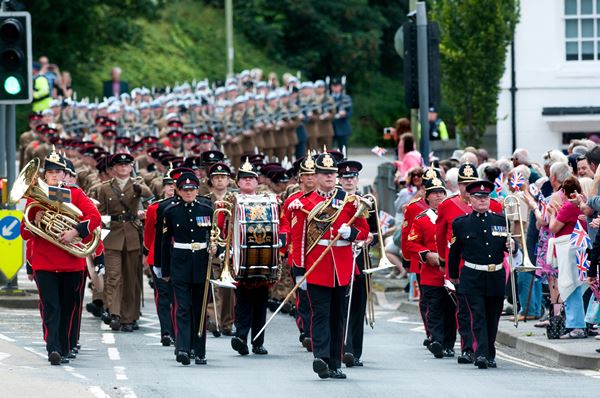
People turn out in their hundreds to support troops
Hundreds of people turned out to watch troops from three military regiments march through Andover on Sunday in celebration of their freedom of the borough.
Hundreds of people turned out to watch troops from three military regiments march through Andover on Sunday in celebration of their Freedom of the Borough.
Service personnel from 22 Engineer Regiment, The Princess of Wales’s Royal Regiment and the Army Air Corps paraded through the town in a spectacular display of ceremony and tradition.
The march set off at 12.45pm from Town Mills car park following an address from the Mayor of Test Valley, Councillor Karen Hamilton. Led by the Princess of Wales’s Royal Regimental Band, the parade headed up Bridge Street towards Eastern Avenue where the troops saluted the Lord-Lieutenant of Hampshire and the Mayor. The march ended at St Mary’s Church where a flypast by the Army Air Corps marked the start of a commemoration service for the 100th anniversary of the Battle of the Somme.
Leader of Test Valley Borough Council, Councillor Ian Carr, said: “I am delighted we were able to bring the troops together for this fantastic event. I would like to thank everyone who turned up on the day to support the troops as well as all those involved in organising the parade.
“It was a real privilege to be there and I am pleased to say that we were lucky enough to enjoy some fantastic weather on the day.”
Lt Col DJ Bickers MBE RE – Commanding Officer 22 Engineer Regiment, said: “The Armed Forces draw much resilience from the strength of their relationships with the communities from which they recruit and in which they are based. I therefore have no doubt that, following the amazing turn out by the people of Andover at Sunday’s Freedom Parade, that the relationship between 22 Engineer Regiment and the community of Andover is in great shape.”
Lt Col AFJ Betts, Commanding Officer 3 PWRR, said: “The TIGERS (3PWRR) were delighted to conduct this Freedom Parade though Andover on Sunday. It was a very special privilege and a real honour; the people of Andover could not have supported us more. Thank you to all that came out to cheer us on!”
Commandant Colonel Jon Bryant, Army Air Corps, said: “The Army Air Corps has very close ties with the local Andover community and we have enjoyed being able to participate in the Freedom Parade. We are grateful for the relationship we have with the public and the appreciation they have shown to us. It was an absolute privilege to have been involved.”
The Freedom of the Borough is the highest award that the Council can bestow. Those granted the freedom are able to march through the streets “with swords drawn, bayonets fixed, colours flying, drums beating and bands playing”.
Information about each of the regiments:
The Corps of Royal Engineers – awarded Freedom on the 28 April 1982
The Corps of Royal Engineers (CRE) traces its origins back to the military engineers brought to England by William the Conqueror. To this day, they offer military engineering and technical support to the British Armed Forces. During battle, the “Sappers” enable troops to move, live and fight, by building temporary accommodation, runways and bridges, and clearing routes through minefields.
During post-conflict reconstruction, the CRE takes on many roles. The Corps is made up of 15 regiments and is represented locally by 22 Engineer Regiment, based at Swinton Barracks near Tidworth in Wiltshire.
The Princess of Wales’s Royal Regiment – awarded Freedom on the 25 June 1986
In 1992, The Royal Hampshire Regiment merged with the Queen’s Regiment to become The Princess of Wales’s Royal Regiment (PWRR), which inherited the Freedom of the Borough granted to The Royal Hampshire Regiment.
Nicknamed the Tigers, the PWRR is the English senior line infantry regiment of the British Army. The regiment has been involved in every major conflict since the Second World War, and is the most decorated in the British Army, having been awarded 57 Victoria Crosses for acts of valour and gallantry.
Army Air Corps – awarded Freedom on the 25 September 1987
On formation in 1942, the Army Air Corps (AAC) comprised of three units: Glider Pilot Regiment (GPR); Parachute Battalions and the Air Observation Post Squadrons (AOP). In 1944, the SAS was also added to the Corps. The AAC was broken up in 1949, with the SAS returning to independent status, while the remainder continued as the GPR and Parachute Corps.
In 1957, the Glider Pilot and Parachute Corps was renamed as The Parachute Regiment, while the GPR and the AOP amalgamated into a new unit, the AAC.
The AAC provides offensive action, intelligence, surveillance, target acquisition and reconnaissance (ISTAR) as well as control and direction of firepower, as well as a variety of other functions.
